Introduction
Developing learning in large organizations can involve a lot of people – all with different priorities, experience and skills. To be successful, everyone needs to work together to deliver the desired results. But this isn’t always happening. According to the Institute, training and development projects commonly fail to add value because of a lack of specific direction and focus.. So, how can you set your projects up for success and drive them forward to deliver impactful digital learning?
It may not be seen as the most exciting or creative part of a project, but your elearning development process can make or break your digital learning. A clear process will help you stay on track while empowering everyone to bring their best to the table. This isn’t just about the success of an individual project. Building in a consistent framework enables you to grow quality and scale-up elearning production with less stress.
At Elucidat, we’ve learned from the wins and war stories of hundreds of learning teams in global enterprise organizations. While no two processes are identical, we’ve identified some critical elements. This guide sets out the must-do steps you need to take to develop successful online learning.
What is an elearning development process?
An elearning development process is a set of steps that get you from “We need some learning to help us with this problem” to “Problem solved!”. It includes checking whether elearning is the best solution, creating the elearning, getting it in front of learners, and refining it over time.
There’s no one ‘right’ process; the details will vary based on factors such as the size of your organization, the skills in your L&D team and the tools you use. But based on our experience supporting L&D teams that create content for over 15 million learners between them, there are some key steps. We recommend you follow these, regardless of your situation.
Think of this as the elearning production process 101.
Benefits of having a clear elearning methodology
With demand for digital learning at an all-time high, the pressure is on to respond at speed. Some elearning teams may be tempted to free fall through their elearning design, making it up as they go along. It’s so easy to communicate throughout the project lifecycle via social working tools that “going with the flow” might feel intuitive. Perhaps there’s also an assumption that creative design requires a blank slate and no fixed rules.
However, we find that organizations that put even basic elearning development processes in place achieve stronger results. They:

Set out and work toward clear goals

Work more efficiently and get learning products to market quicker

Reuse tools and templates to their creative advantage

More easily onboard and bring stakeholders along with them on the journey

Proactively put lessons learned from other projects into new ones

Involve end users and – most importantly – put them at the heart of every stage
So, how do you develop a process that maximizes these benefits? Read on to explore the most common elearning development processes and see our recommended steps and tips for successful production – from start to finish.
What’s the best development process to use?
If you search for “elearning development processes,” you’re sure to find plenty of different results and lots of debate around which is the best one to use. Here’s a quick overview of some of the most common models and their pros and cons:
ADDIE
ADDIE is a longstanding elearning development process. It stands for Analyze, Design, Development, Implementand Evaluate. In its traditional form, it guides you systematically through one stage at a time. The idea is that you don’t move on to the next stage until “sign off” of the previous stage is complete. More modern takes on ADDIE recognize the risk of not evaluating until a project is launched and put evaluation into each stage.
ADDIE’s evaluation stage is often synonymous with Donald Kirkpatrick’s Four Levels of Learning Evaluation. This is a relatively in-depth and high input form of evaluation that teams often skip due to time constraints.
ADDIE Pros: Easy to implement. Projects are signed off along the way.
ADDIE Cons: Locked down approach that may leave evaluation too late or out of the picture.
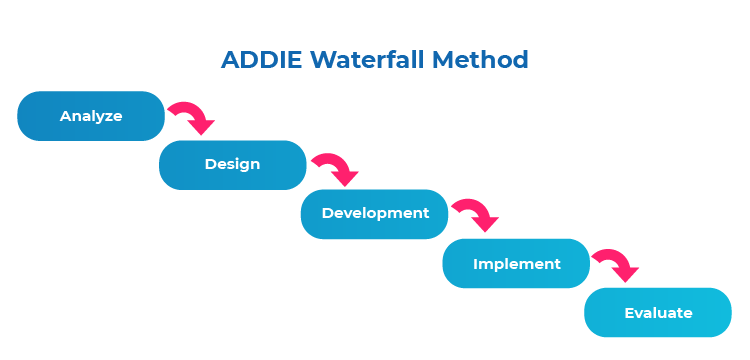
Agile
At the other end of the spectrum is the more modern Agile approach. Starting as a software development process, it’s spun off into other applications, including for learning design. At its core is the idea that small multi-skilled teams work collaboratively in “sprints” – short time frames of 1 – 4 weeks – to develop and iterate a solution.
The aim is to have something tangible to share and test with both stakeholders and learners after each sprint. This focus on testing and iterating gives you confidence that the final result will have the desired impact. It also means you have to be open to including your users and sometimes hearing tough feedback, which some teams struggle with.
With authoring tools making it quicker and easier to dive in and produce prototypes and designs, it’s no surprise that this is a popular elearning design process for many.
Agile Pros: Nimble, collaborative and iterative, with the focus on producing something to test over re-working abstract design documents. Brings stakeholders together regularly.
Agile Cons: Not all stakeholders are “agile” aligned and may struggle to work in sprints. Some may struggle to work piecemeal.
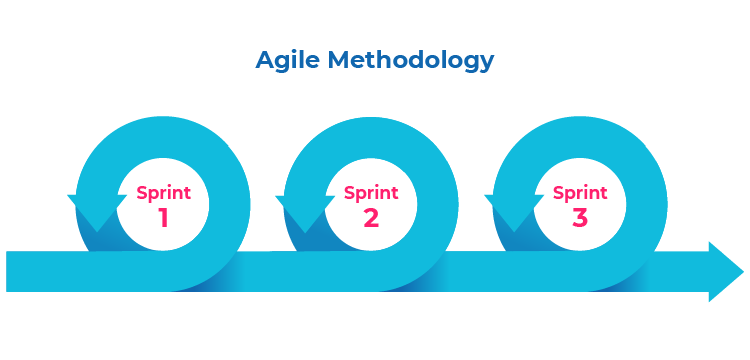
5Cs
While the above processes can be applied to many design and development projects, the 5C Framework has been created for elearning projects specifically. Learning design experts here at Elucidat observed the varying processes used by our customers and took the best bits to form a 5-step process with Return On Investment (ROI) and impact at the center.
The 5Cs are:
- Capture – start with a clear plan, performance-focused goals and personalized user profiles
- Conceptualize – form design ideas around the goals and lead with a prototype
- Create – build out the solution with confidence (testing as you go)
- Cultivate – use learning analytics to improve and refine the solution
- Commercialize – plan and refine how your project will deliver a clear ROI
You’ll notice that the 5th C – Commercialize – runs alongside the other 4Cs. That’s because every project should be focused on and tied to a clear ROI, bringing clear value to end users and reaching as many people as it can. Having this mindset from the start helps elearning development teams stay focused on measurable goals and impact.
5C Framework Pros: Easy to use. Comes with free tools. Puts end users and measurable performance improvements at the heart of the process.
5C Framework Cons: Because it focuses on end users and real-life goals, it can be a bit of a leap for non-designers to land on design ideas that fit that specific bill.
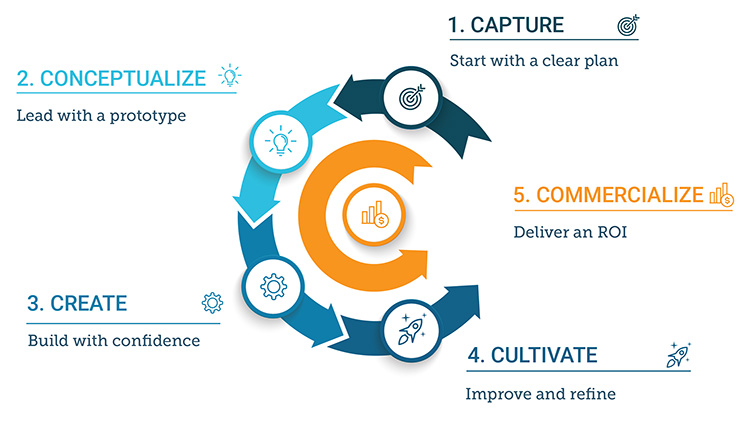
Access free tools and templates to guide you through the 5Cs process
The 4 must-do steps for developing successful elearning
Having outlined some of the processes out there, let’s dive into the detail. Here are four steps that take the best bits from all these processes and translate them into practical actions you can take to make your elearning a success.
Step 1: Set out clear goals for your elearning project
Learners decide in just 7 seconds whether online content is worth their attention. So, what makes it worth their attention? The answer will be different for every piece of elearning and every audience. That’s why every project should start with user profiles and measurable goals. Let’s look at each in turn.

“Think about how you can advocate for your learners. Ask why is this useful? What’s the purpose we serve by implementing this program? I really think that we have an opportunity to influence from a learner centric perspective.”
Stella Lee, Founder, Paradox Learning
Create user profiles
When we talk about learning, we’re really talking about changing people’s behaviors and habits. To be successful, you need to get under the skin of your audience. Who are they? What would really help them? What are their go-to places for help currently? What would motivate them to take action? To find out, you need to speak to your learners. At Elucidat, we run an annual study to understand what modern enterprise learners want. But there are lots of other ways to get to know your audience: have conversations, run surveys, observe them, use learning analytics from previous projects and more.
Off the back of what you discover, set up some user profiles.

Set measurable goals
Once you understand your users, get super clear how your elearning project is going to add value to them. Work with stakeholders upfront to decide on the goals you are going to measure for your learning project. Think beyond mere completions and scores, to the business impact you want to have. Ask yourself:
How will I know this elearning has been a success?
If everyone aces this elearning, what will change in the business as a result?
Which business metrics (e.g. sales, customer satisfaction) will this elearning impact?
The idea is to set out the data you’ll track and look for correlations with your elearning.

“Prior to designing a learning solution, let’s have the conversation about the intention. Let’s define what purpose fulfilled looks like. Because if we can define what purpose fulfilled looks like, we can measure the extent to which that purpose was fulfilled.”
Kevin M. Yates, L&D Detective
Using L&D detection to find measures that show purposeful impact
Download for free the Project Planning Template for successful learning
Step 2: Create a clear design vision
With your elearning project goals clear in your mind, set about generating some ideas for how they can be met. This is a great step to do collaboratively, using brainstorming techniques. Crucially, we would recommend you don’t look at the course content to do this. Instead think about what types of activities, experiences, tools and tips are most likely to work for the audience and goals.
Everyone does this differently, so here are some techniques to try as you find out which works best for you:
Mindmapping
Exploring ideas freely and sometimes collaboratively, primarily through text
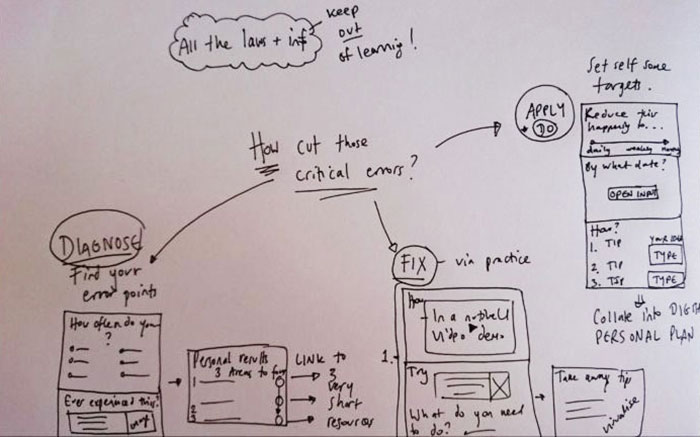
Storyboarding
Setting out a sequence of potential pages or videos, like a comic strip
A great way to build out solutions based on building competency and change
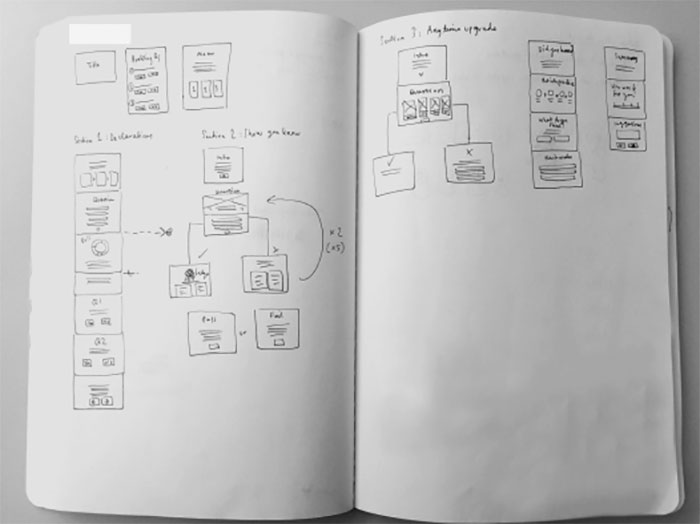
Cathy Moore’s Action Mapping
A great way to build out solutions based on building competency and change
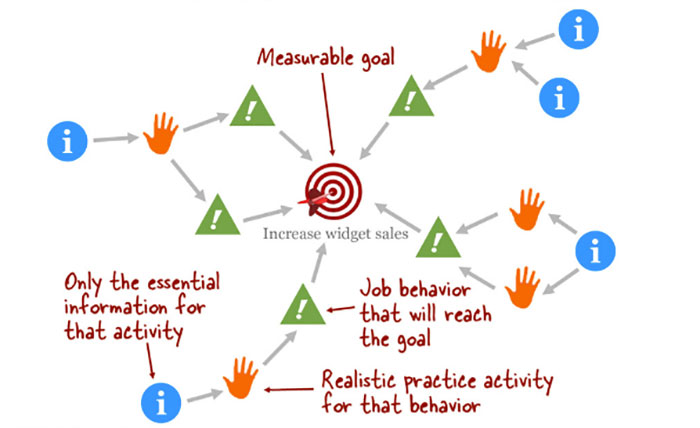
Wireframing
Sets out layouts and sample content, without getting caught up in styling
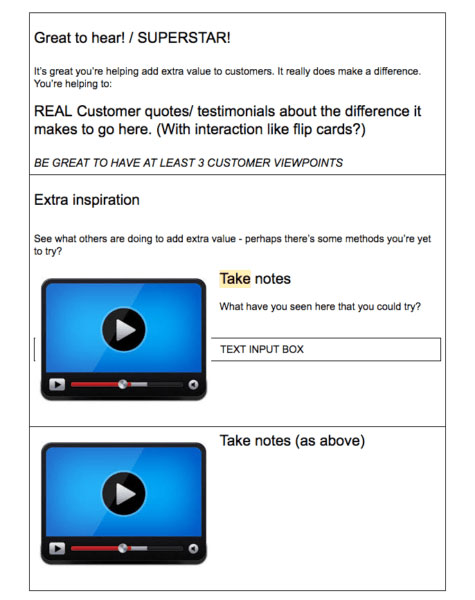
Prototyping
Visual styling and interactive walkthroughs of an idea to test reactions
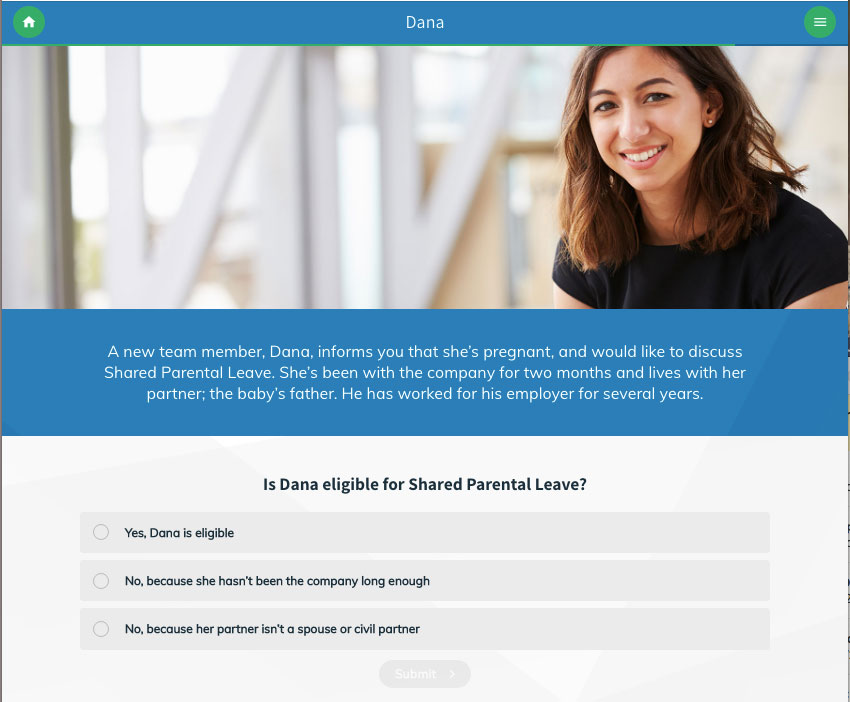
Prototyping is a crucial step. Even if you’ve worked up ideas on paper, always look to build out something interactive for stakeholders to play around with and review. This could be 5 minutes of your 20-minute topic.
Don’t make prototyping a big deal. Do it early, do it regularly, do it collaboratively. Or, even better, choose an authoring tool that builds you a ready-made prototype in just a few clicks. Embracing prototyping will enable you to improve your design and make your project better in the long run. If you don’t seek or choose to ignore feedback, you’re probably creating your own art project rather than a user-centered design project!
Of course, you don’t have to start from a blank canvas. Seek inspiration from elearning examples, many of which are available for re-use.
Like the idea of a ready-made course structure you can test and iterate?
Find out more about Elucidat’s best practice templates here, and start a free trial.
Step 3: Develop detailed content, smartly
It’s time to get stuck into developing the detailed content, but this doesn’t mean opening the floodgates to the Subject Matter Expert’s (SME’s) cupboard of content. Hold back on that PowerPoint if you can! This stage is often overlooked as the “easy” step in production. You have your design pinned down, so it’s just a case of writing the content, creating the graphics and putting it all together, right? Not quite.
Avoid the temptation to copy and paste dry content into an authoring tool. This won’t result in an effective learning experience. Instead, flip your thinking and make your design model the blueprint. Use the subject matter to support the learning experiences you’re setting out to create. Here’s how…
Design first, content second
It’s often the case that the SMEs for your project don’t come from a learning design background. They might be health and safety experts, compliance officers, sales trainers – ultimately they’re experts in their area rather than in learning. Your challenge is to take their expertise and shape it into a format that fits with your area of expertise – the learning design approach you sketched out in step 2.
Here are two ways to do this.
Collaborate with your SMEs in your elearning authoring tool
Modern authoring tools know that collaboration and crowdsourcing of content is the future, so they’re set up to allow SMEs to actively contribute to the production of elearning content. This is particularly important where elearning needs to be created at scale. Through effective collaboration within your authoring tool, SMEs can create high quality content to help meet demand and take the pressure off you and your team.
So, how would this work in practice?
You can take the prototype you created in step 2, amend it based on user feedback, then invite your SMEs to add their content directly into it. The built prototype already has the activities and interactions built in so your SMEs are adding content into that framework rather than simply adding paragraphs of text. You can work on the project with them at the same time, finessing wording and supporting them with visuals and practical activities.
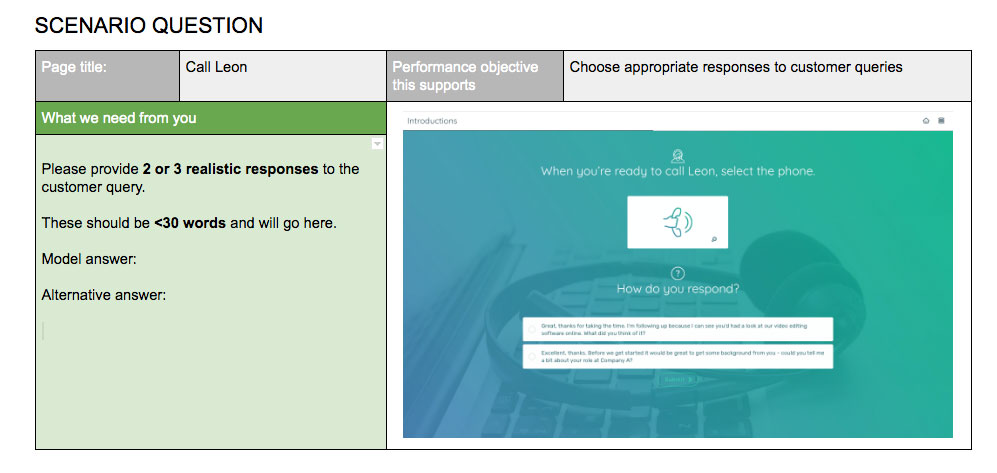
Collaborate on paper
If your elearning authoring tool doesn’t support collaboration, you could set up some paper-based templates to capture the right kind of content. You may have done this already as part of your design concept work. These could be storyboard or wireframe style templates that mimic the design approach you’ve agreed on. Or they could be templates built in an elearning authoring tool of your choice.
Don’t just hand over the design to them to fill in. Work closely with the SME to explain the kind of content you need from them and what the learner needs to be able to do after the elearning (not just know). Hopefully, they’ll have been involved in your process from the start, so will be in-the-know. This is where your content capture templates come into their own.
Notice how this storyboard guides the SME as they add their content. Ideas, suggestions and word counts all help make sure that the content is provided in a way that fits with the design you’ve already agreed.

“The L&D function’s job is to say: You’re the experts. Here are some ways that we’ve set up that make it really easy for you to share your expertise.”
Heather Gilmartin Adams, Senior Analyst, RedThread Research
Curate – don’t always create
Not everything needs creating from scratch. Often, those teams that meet learning needs most effectively are drawing on useful resources and tools that others can benefit from. Pull together, or ask the SME to pull together, any useful existing content that fits your design model. For example, there might be some great on-the-job resources or some YouTube videos that explain the theory better than you ever could (for free?!). Perhaps there’s an existing workshop activity you can rework or an assessment that works well and you can copy?
Get building your content
Once you’re clear on what each page needs to include, you can start putting it all together. Our top tip here is to borrow from Agile and work in sprints. For example:
- Set up your overall styling and navigation elements
- Set up any elements that will be replicated and re-used – e.g., topic structures, menus and/or pages you will re-use
- Build out one topic first – check in on feedback and make changes
- Build out the other topics in parallel or one at a time – checking in on feedback as they are completed and make changes
- QA as you go, but always fully at the end
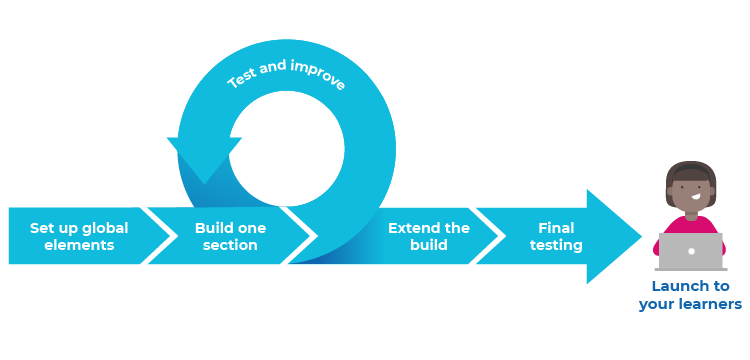
Involve stakeholders along the way – especially some sample end users! And don’t be scared to invite others in to edit the content directly, if your tool makes it easy enough to do so.
Involving the right people at the right time will make your elearning process a success
Find out more about this in this Guide to Building an Elearning Dream Team
Step 4: Evaluate engagement and impact
If you’ve followed this elearning development process from the start, you will have designed your elearning around a specific business goal. This could be an increase in sales of a particular product, an improvement in a Net Promoter Score (NPS), a reduction of reported safety incidents – the list goes on. This final step is about evaluating the impact you’re having on that goal and iterating where necessary.
Measure engagement
Many L&D teams are already hot on measuring completion of their elearning courses. This is a great start, but in truth it’s only the first indication of learner engagement. Try digging a bit deeper on a continuous basis, by asking yourself some of these questions:
- Which topics within your elearning are most popular? This could indicate your audience is actively looking for support in certain areas.
- Which questions are your audience getting right with no problem, and which questions are tripping them up? This could indicate knowledge gaps that impact performance.
- Which countries / departments / locations are engaging most with the elearning? This could indicate where you need to do another round of promotion.
Most modern authoring tools will come with built in analytic dashboards that provide this information at a glance. If you don’t have a ready-made dashboard, consider choosing a few key metrics and setting one up for yourself.
Measure impact
With a clear understanding of engagement, it’s time to take your evaluation to the next level. What impact has the elearning had on your business goals? Has it delivered ROI? To work this out, you need to return to your original goal, decided in step 1.
Review your goal and the business metric you plan to impact. Make sure you have a benchmark to measure against.
When you have reached significant engagement levels with your elearning, measure your key metric again and compare it to your benchmark. How are you doing?
Use what you’ve learned from your engagement data to double down your efforts. E.g. if you’ve seen more engagement and more improvement in the US compared to the UK, get UK managers involved in promoting the elearning again.
Evaluating your elearning has the potential to be very complex, but don’t let that stop you from doing anything at all. A handful of the right data points can be enough to measure success.

“Try some stuff. Do a pilot. Do something smaller. Focus on an area where you have an engaged audience already, and try a few little tweaks…You know, it doesn’t have to be big.”
Ashley Sinclair, Managing Director, MAAS Marketing
Identifying the data that really means something on your project is the key to measuring what counts
Find out more about this in this Guide to Using Data to Design and Refine Elearning
How to speed up elearning content development even more
There’s a fine balance between quality and speed within L&D. Your elearning must be high quality in order to make an impact. But, spend too long perfecting and polishing your elearning and you miss a big window to make an impact. Smart production is about finding the minimum viable product to do the job well, but not overdo it.
Work collaboratively
If you’ve been holding your SMEs and stakeholders at arm’s length, trying to retain control over all aspects of your elearning, consider this your invitation to share the load. Engaging and empowering your SMEs to directly contribute to your elearning is a game changer. They can work into an elearning authoring tool itself, seeing the content come to life and why 300-word blocks of text just aren’t going to cut it. Set them up for success with templates that have design best practice baked in and. With the right support, SMEs can play a key part in helping you achieve quality elearning at scale.
To make it work, you’ll need: A cloud-based authoring tool with smart permission settings that allow you to give your SMEs the permissions they need, and no more!
Find out more about Elucidat’s advanced user management.
Set up reusable elements
There’s no need to start from scratch with each project. Make life quicker and easier by setting up reusable visual styles, elearning structures and page layouts. This will allow you to prototype solutions fast and give you a base from which to make changes for each specific project.
To make it work, you’ll need: An authoring tool that allows you to create and save reusable elements and templates. Or, even better, one that comes pre-loaded with over 25 elearning course templates that you can use as a starting point for your projects.
Find out more about Elucidat’s expert designed, customisable templates.
Test early
Don’t waste time perfecting an elearning module just to realize it’s not having the impact you hoped. Embrace the idea of a Minimum Viable Product, then test, iterate, and test again.
To make it work, you’ll need: A pilot group of learners for each elearning project you create and a tool that enables you to quickly create, publish and analyze your prototypes.
Find out more about Elucidat’s learning analytics suite.
Resource list
Elearning production processes
- Definition of the ADDIE Model: Wikipedia
- Definition of the Agile Model: Wikipedia
- The 5C elearning Framework: Elucidat
Theory around learning production successes and failures
- Why Training and Development Fails: ROI Institute
- Professionalising Learning Report: CIPD
- People-Centred Learning. The modern learning manager’s strategic guide to deliver maximum value: Elucidat.
Other methods for learning analysis and evaluation
- Conducting a Learning Needs Analysis: CIPD
- Using the Action Mapping Technique: Cathy Moore
- Kirkpatrick’s Four Levels of Learning Evaluation: Kirkpatrick
Summary
Whatever way you choose to go with your elearning development process and the exact order you complete each step, three key things are clear:
Collaborative and iterative elearning production processes that involve stakeholders along the way – especially SMEs and end users – produce better outcomes and are more likely to hit their target.
Learning production processes that put time into upfront analysis, clearly shape their goals and keep everyone concentrated on these, and ultimately produce higher ROI.
Learning development that uses data and learning analytics to tweak and refine along the way deliver more impact.
We can help you do it!
Get a smarter, faster way to produce transformative elearning with Elucidat’s authoring platform.
We’ll even tailor your demo to show you how we can help you solve your biggest elearning challenges.
